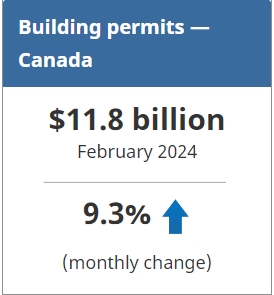Statistics Canada: Building Permits, February 2024

Month over month, the total value of building permits in Canada increased 9.3% to $11.8 billion in February. The non-residential sector grew 12.3% to $4.7 billion due to the issuance of several major construction permits, while the residential sector increased 7.4% to $7.1 billion. Ontario (+21.7% to $5.0 billion) led the growth, with gains occurring across all components.
On a constant dollar basis (2017=100), the total value of building permits was up 8.5% in February, following a monthly increase in January.
Industrial projects lead non-residential construction intention gains
The total monthly value of non-residential permits increased 12.3% to $4.7 billion in February.
The growth was mostly attributed to the industrial component, which increased 57.8% to $1.3 billion in February. Permits for large industrial construction projects were issued across the country. They included permits for the construction of a new battery plant in Windsor, Ontario, a new dairy processing facility in Abbotsford, British Columbia, a new pea processing plant in Yorkton, Saskatchewan, and the expansion of an aluminum smelting facility in Saguenay, Quebec.
The monthly growth in the non-residential sector in February was also supported by the increase in the institutional component (+18.2% to $1.3 billion).
Ontario drives growth in residential construction intentions
The total monthly value of residential permits increased 7.4% to $7.1 billion in February. Ontario (+14.2% to $2.8 billion) contributed the most to the rise in value of both single-family and multi-family dwelling permits.
Intentions for residential construction growth were divided between single-dwelling (+9.6%; +$248.2 million) and multi-dwelling (+6.0%; +$239.3 million) permits in February.
In addition to Ontario, British Columbia (+5.9%; +$76.4 million), Quebec (+3.9%; +$44.2 million) and Alberta (+3.9%; +$41.7 million) were the primary contributors to the second consecutive monthly increase in the residential sector.
Across Canada, 16,400 new dwellings in multi-unit buildings and 4,600 new single-family dwellings were authorized in February. From March 2023 to February 2024, a total of 253,400 new units were authorized.
To explore data using an interactive user interface, visit the Building permits: Interactive Dashboard.
For more information on construction, please visit the Construction statistics portal.
For more information on housing, please visit the Housing statistics portal.
To view original post click here.
Note to readers
Unless otherwise stated, this release presents seasonally adjusted data with current dollar values, which facilitate month-to-month and quarter-to-quarter comparisons by removing the effects of seasonal variations. For information on seasonal adjustment, see Seasonally adjusted data – Frequently asked questions.
Building components
- Single-family dwellings: Residential buildings containing only one dwelling unit (e.g., single-detached house, bungalow, linked home [linked at the foundation]).
- Multi-family dwellings: Residential buildings containing multiple dwelling units (e.g., apartment, apartment condominium, row house, semi-detached house).
- Industrial buildings: Buildings used in the processing or production of goods or related to transportation and communication.
- Commercial buildings: Buildings used in the trade or distribution of goods and services, including office buildings.
- Institutional and government buildings: Buildings used to house public and semi-public services, such as those related to health and welfare, education or public administration, and buildings used for religious services.
Revision
Data are subject to revisions based on late responses, methodological changes and classification updates. Unadjusted data have been revised for the previous month. Seasonally adjusted data have been revised for the previous three months.
For information on trend-cycle data, see the page Trend-cycle estimates – Frequently asked questions.
Next release
Data on building permits for March will be released on May 13. With that release, data for January 2023 through December 2023 will also be revised.
Source: Statistics Canada


